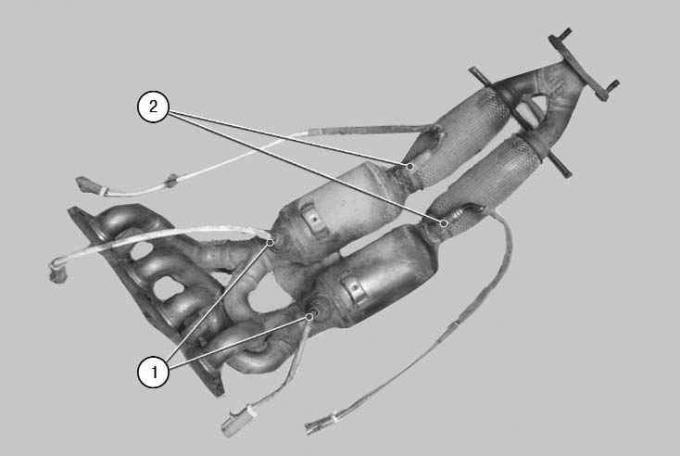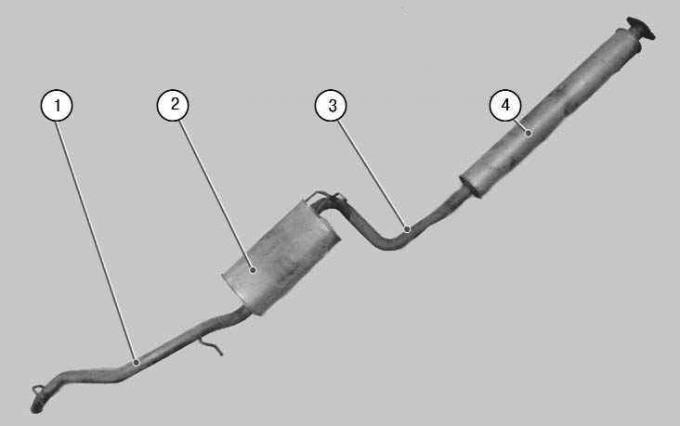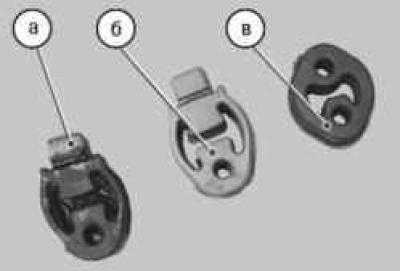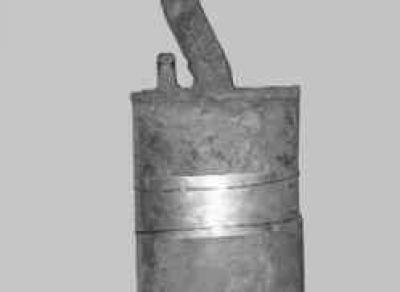
Pic. 5.24. Catcollector: 1 - control sensors for oxygen concentration in exhaust gases; 2 - diagnostic sensors for oxygen concentration in exhaust gases
Exhaust gases are removed from the engine through the collector (pic. 5.24) (exhaust manifold combined with converters), optional 4 (pic. 5.25) and main 2 mufflers.

Pic. 5.25. Nodes of the exhaust gas system located on the base of the body: 1 - exhaust pipe; 2 - main muffler; 3 - intermediate pipe; 4 - additional muffler
The collector has two main (managers) oxygen concentration sensor 1 (see fig. 5.24) And (after neutralizers) two diagnostic sensors 2.
A sealing metal-reinforced gasket is installed between the flanges of the cylinder head and the collector.
Receiving pipe of the additional muffler 4 (see fig. 5.25) connected to the collector, and its outlet pipe - with the main muffler 2. The connections of the intake and intermediate 3 pipes with an additional muffler, as well as the intermediate and exhaust 1 pipes with the main muffler are welded and therefore non-separable. The flange connection of the intake pipe of the additional muffler and the collector is sealed with a metal-reinforced gasket. Thus, all elements of the exhaust system, located on the base of the body, are made in one piece and cannot be dismantled separately without the use of a metal-cutting tool. However, spare parts are supplied with individual elements of the system, which, when mounted on a vehicle, are connected by welding or special couplings.

The elements of the system are suspended from the body on five rubber cushions. Moreover, the pillow and the rear suspension of the exhaust pipe, the pillow b the suspension of the front part of the main muffler and three pillows in the suspension of the collector and the rear part of the main muffler have a different shape.
To protect the engine and the base of the body from heating by the elements of the system, thermal screens made of heat-resistant non-woven material are installed above the collector, additional and main mufflers and above the exhaust pipe. In addition, an additional steel thermal screen is installed above the collector.
The exhaust system does not require special maintenance. It is enough to periodically check the reliability of the tightening of the threaded connections and the integrity of the suspension pads. In case of damage to the elements of the system, through corrosion or burnout, they are replaced as an assembly, since the mufflers, together with the pipes, are non-separable units.
GOOD ADVICE: Periodically check the exhaust system. If there is an increased noise level from the exhaust system, check its tightness. To do this, start the engine and inspect the entire system. By running your hand over the places of a possible leak, without touching the nodes, you will immediately feel the leakage of gases. If necessary, replace rusted and burnt parts.
WARNING: Before repairing the exhaust system, allow it to cool down as it becomes very hot when the engine is running.
WARNING: Exhaust gases are poisonous, poisoning by them occurs imperceptibly, therefore, before starting the engine in the garage, be sure to open the gate!

USEFUL ADVICE: If it is impossible to replace a defective assembly with a new one, you can temporarily restore its performance by applying a metal patch to the damaged area and securing it with clamps or wire. It is recommended to place a sheet of asbestos under the patch.
GOOD ADVICE: In addition, auto parts stores sell special kits for rebuilding exhaust system components, with which you can temporarily repair damage to the system in order to get to a car service or garage.
Visitor comments